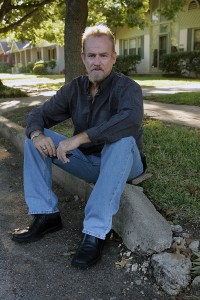After his wife convinced him to do something about the conditions on Forest Park, Brown met with staffers from the city’s Transportation and Public Works Department, who told him that additional traffic lights and stop signs on the street would be too costly a solution for slowing traffic. He began to investigate the idea of a road diet and has since crusaded for it. He built a strong coalition that includes Price, Fort Worth City Council member Joel Burns, and the two associations representing the neighborhoods that bracket Forest Park.
When TPW director Doug Wiersig told Brown he wanted to make sure the neighborhood was behind the measure, Brown put together a slide show that he has now presented five times, including at meetings where he convinced the Berkeley Place Association and the Mistletoe Heights Association to endorse the road diet. When Wiersig asked for more, Brown hand-delivered about 80 fliers promoting another meeting at a church, for those whose homes are adjacent to the boulevard. The homeowners who showed up voted 13 to 3 in favor of the changes.

Eventually Brown gained the support of Burns, who wasn’t initially on board with the plan, for fear it would divert traffic deeper into the neighborhood. But after consulting with city engineers, the council member came around.
“It’s complex,” Burns said. “On the surface it may not seem logical to reduce the lanes from four to three and still be able to flow the same amount of traffic in the same amount of time and make it safer.”
Supporters of the plan note that TPW’s data show the re-striped lanes will only add five seconds to the average commute through the one-mile stretch. They say the data collected from similarly configured streets in other cities suggest that Forest Park will be able to handle as much traffic as it does now, with far fewer accidents.
City engineers assured Burns that the diet will reduce rear-end and sideswipe wrecks. Crashes are typically reduced by about 29 percent on such roads, and the crash severity isn’t as extreme because the cars are moving more slowly. Traffic flows better, city engineers told Burns, because a lot of congestion is caused by people who are turning left, a problem alleviated by the center turn lane. Congestion is also caused by cars jockeying for position, bobbing back and forth from lane to lane.
“It actually doesn’t add any transit time at all,” Burns said. The decision on the new configuration “came down to a question of safety: Can we provide the same functionality and the same flow and the same amount of travel time and make it safer? And that’s what made it easy to support.”
City staffers documented 41 wrecks on Forest Park between 2009 and 2011. Brown’s own research found more than 90 crashes in that time span — he counted every accident called in to police, whereas the city counted only the ones that the police investigated.
The city did not provide the Weekly with comparative data on accident rates on similar streets; staffers said they could not find a similarly designed street for accurate comparison.
The city robo-called residents about yet another meeting at the Hilton Garden Inn in September 2012. More than 400 people showed up, along with TPW staff and Burns. City officials put charts of the changes on display. Engineers showed a computer model of how traffic would flow.
Attendees were asked to fill out a survey, also posted online, asking if they supported the measure. They split 60-40 in favor of the diet.
“It wasn’t an overwhelming majority, nor was it a slim margin,” said Brown.
Burns said that he felt the city did its due diligence in engaging citizens, but it was the endorsement of the TWP engineer that ultimately convinced him it was a good idea.
“It was the recommendation of the traffic engineer. This wasn’t a case of the majority getting whatever it wants; the engineers came forward with a really strong recommendation,” he said.
Since April the project has been delayed by weather and then by a city contractor’s bankruptcy. City officials said that the re-striping could start next month or be delayed again until the spring.
Council members Jungus Jordan and W.B. “Zim” Zimmerman have raised questions about the project and suggested another delay, but neither has pushed that option yet.
“The bottom line is, the engineers are probably right,” said Jordan. “The redesign is going to calm traffic, but it’s also going to divert traffic to other routes. My [preference] is, let’s wait until we can divert it to the Chisholm Trail Parkway, when we have options we’ve never had in the past.”
The parkway, a 27.6-mile toll road from downtown Fort Worth south to Cleburne, is expected to open sometime next year.
********











